Salesforce Marketing-Cloud-Intelligence Marketing Cloud Intelligence Accredited Professional (AP-215) Exam Practice Test
Total 63 questions
Marketing Cloud Intelligence Accredited Professional (AP-215) Questions and Answers
Which three statements describe Overarching Entities? 03m 23s
A client created a new KPI: CPS (Cost per Sign-up).
The new KIP is mapped within the data stream mapping, and is populated with the following logic: (Media Cost) / Sign-ups)
As can be seen in the table below, CPS was created twice and was set with two different aggregations:

From looking at the table, what are the aggregation settings for each one of the newly created KPIs?
A)

B)

C)

D)

A technical architect is provided with the logic and Opportunity file shown below:
The opportunity status logic is as follows:
For the opportunity stages “Interest”, “Confirmed Interest” and “Registered”, the status should be “Open”.
For the opportunity stage “Closed”, the opportunity status should be closed Otherwise, return null for the opportunity status.

Given the above file and logic and assume that the file is mapped in the OPPORTUNITIES Data Stream type with the following mapping:
“Day” — “Created Date”
“Opportunity Key” + Opportunity Key
“Opportunity Stage” — Opportunity Stage
A pivot table was created to present the count of opportunities in each stage. The pivot table is filtered on Jan 11th. What is the number of ‘opportunities in the Confirmed Interest stage?
A client's data consists of three data streams as follows:
Data Stream A:

* The data streams should be linked together through a parent-child relationship.
* Out of the three data streams, Data Stream C is considered the source of truth for both the dimensions and measurements.
How should the "Override Media Buy Hierarchies” checkbox be set in order to meet the client's requirements?
What are unstable measurements?
A technical architect is provided with the logic and Opportunity file shown below:
The opportunity status logic is as follows:
For the opportunity stages “Interest”, “Confirmed Interest” and “Registered”, the status should be “Open”.
For the opportunity stage “Closed”, the opportunity status should be closed.
Otherwise, return null for the opportunity status.
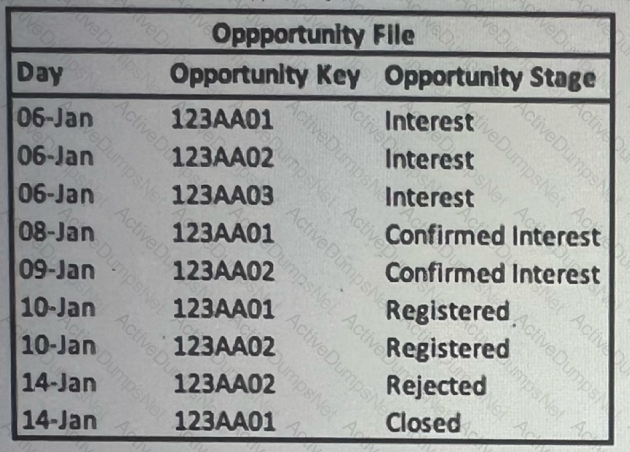
Given the above file and logic and assuming that the file is mapped in a GENERIC data stream type with the following mapping:
“Day” — Standard “Day” field
“Opportunity Key” > Main Generic Entity Key
“Opportunity Stage” — Generic Entity key 2
A pivot table was created to present the count of opportunities in each stage. The pivot table is filtered on Jan 7th -11th.Which option reflects the stage(s) the opportunity key 123AA01 is associated with?
An implementation engineer has been asked to perform QA for a standard file ingestion, done by the client.
The source file that was ingested can be seen below:

The number of rows added to this data stream is 3. What could have led to this discrepancy?
A client's data consists of three data streams as follows:
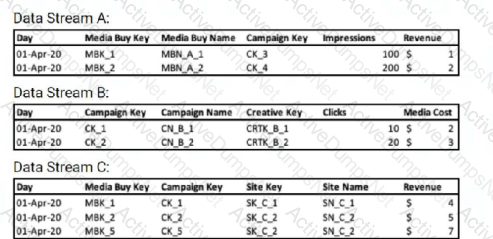
* The data streams should be linked together through a parent-child relationship.
* Out of the three data streams, Data Stream C is considered the source of truth for both the dimensions and measurements.
Which data stream should be set as a parent?
A client has provided you with sample files of their data from the following data sources:
1.Google Analytics
2.Salesforce Marketing Cloud
The link between these sources is on the following two fields:
Message Send Key
A portion of: web_site_source_key
Below is the logic the client would like to have implemented in Datorama:
For ‘web site medium’ values containing the word “email” (in all of its forms), the section after the “_” delimiter in ‘web_site_source_key’ is a 4 digit
number, which matches the 'Message Send Key’ values from the Salesforce Marketing Cloud file. Possible examples of this can be seen in the
following table:
Google Analytics:

Salesforce Marketing Cloud:

The client's objective is to visualize the mutual key values alongside measurements from both files in a table.

In order to achieve this, what steps should be taken?
Your client is interested in ingested the below file to a new generic data stream type:

The field ‘Meeting Code’ was mapped to the main entity key. ‘How should the ‘Room Number’ be mapped?
A technical architect is provided with the logic and Opportunity file shown below:
The opportunity status logic is as follows:
For the opportunity stages “Interest”, “Confirmed Interest” and “Registered”, the status should be “Open”.
For the opportunity stage “Closed”, the opportunity status should be closed
Otherwise, return null for the opportunity status
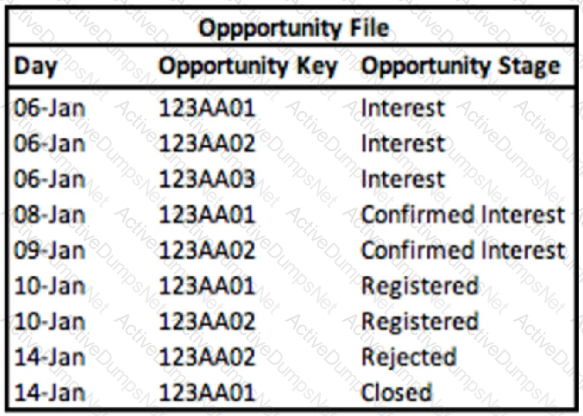
Given the above file and logic and assuming that the file is mapped in a GENERIC data stream type with the following mapping:
“Day” — Standard “Day” field
“Opportunity Key” > Main Generic Entity Key
“Opportunity Stage” — Main Generic Entity Attribute
“Opportunity Count” — Generic Custom Metric
A pivot table was created to present the count of opportunities in each stage. The pivot table is filtered on Jan 11th. What is the number of opportunities in the Interest stage?
Your client has provided sample files of their data from the following data sources:
Google Campaign Manager

Below are the requirements from the client and additional information:
* The sources are linked to each other by shared Media Buy names.
* In addition to the mutual Media Buys, the sources contain campaign and site values. However, the client would like to see the campaign/site values coming from Google CM and not from Google DV360.
* The source of truth for cost is Google DV360
Which action(s) are needed to take place in order to meet the client’s requirement and set Google DV360 as the source of truth for Cost?
A client’s data consists of three data streams as follows:
Data Stream A:
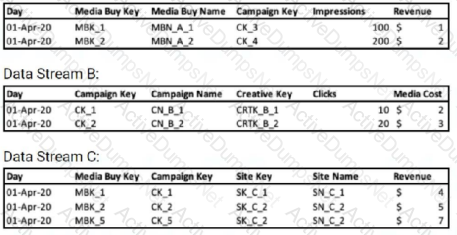
* The data streams should be linked together through a parent-child relationship.
* Out of the three data streams, Data Stream C is considered the source of truth for both the dimensions and measurements.
Assuming the data was ingested properly and the Parent Child was created correctly according to the client's requirements, what is the total
Impressions value for Campaign Key ‘CK_3’?
Which two statements are correct regarding variable Dimensions in marketing Cloud intelligence’s data model?
Client has provided sample flies of their data from the following data sources:
Google Campaign Manager

Below are the requirements from the client and additional information:
• The sources are linked to each other by shared Media Buy names.
• In addition-to the mutual Media Buys, the sources contain campaign and site values. However, the client would like to see the campaign/site values coming from Google CM and not from Google DV360.
• The source of truth for cost is Google DV360.
As a first step, a Parent-Child relationship was created between the two files, and the following mapping was performed, within both data streams:

Please note:
• All other measurements were mapped as well to the appropriate fields.
• No other mapping manipulations or formulas were implemented.
How many records will the merged table hold?
A client has integrated data from Facebook Ads. Twitter ads, and Google ads in marketing Cloud intelligence. For each data source, the source, the data follows a naming convensions as …
Facebook Ads Naming Convention - Campaign Name:
CampID_CampName#Market_Object#object#targetAge_TargetGender
Twitter Ads Naming Convention- Media Buy Name
MarketTargeAgeObjectiveOrderID
Google ads Naming Convention-Media Buy Name:
Buying_type_Market_Objective
The client wants to harmonize their data on the common fields between these two platforms (i.e. Market and Objective) using the Harmonization Center. Given the above information, which statement is correct regarding the ability to implement this request?
wet Me - Given the above information, which statement i 's Correct regarding the ability to implement this request?
A technical architect is provided with the logic and Opportunity file shown below:
The opportunity status logic is as follows:
For the opportunity stages “Interest”, “Confirmed Interest” and “Registered”, the status should be “Open”.
For the opportunity stage “Closed”, the opportunity status should be closed Otherwise, return null for the opportunity status.
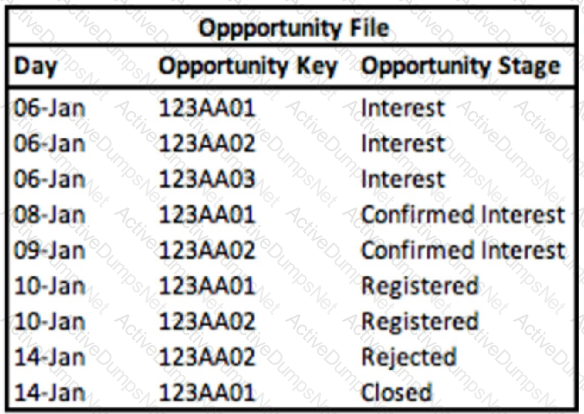
Given the above file and logic and assuming that the file is mapped in a generic data stream type with the following mapping
“Day” — Standard “Day” field
“Opportunity Key” > Main Generic Entity Key
“Opportunity Stage” + Generic Entity Key 2
A pivot table was created to present the count of opportunities in each stage. The pivot table is filtered on Jan 7th - 11th. Which option reflects the stage(s) the Opportunity key 123AA01 is associated with?
Your client would like to create a new harmonization field - Exam Topic.
The below table represents the harmonization logic from each source.

As can be seen from the table, there are in fact two fields that hold a certain connection: Exam ID and Exam Topic. The connection indicates that
where an Exam ID is found - a single Exam Topic value is associated with it.
The client has a requirement to be able to view measurements from all data sources sliced by Exam Topic values, as seen in the following
example:

The client suggested to create, without any mapping manipulations, several patterns via the harmonization center that will generate two
Harmonized Dimensions:
Exam ID
Exam Topic
Given the above information, which statement is correct regarding the ability to implement this request with the above suggestion?
Total 63 questions
